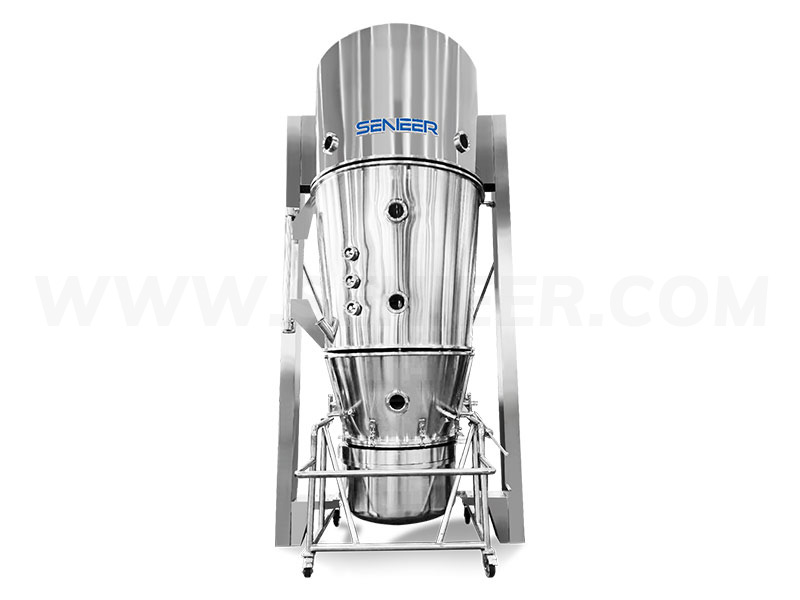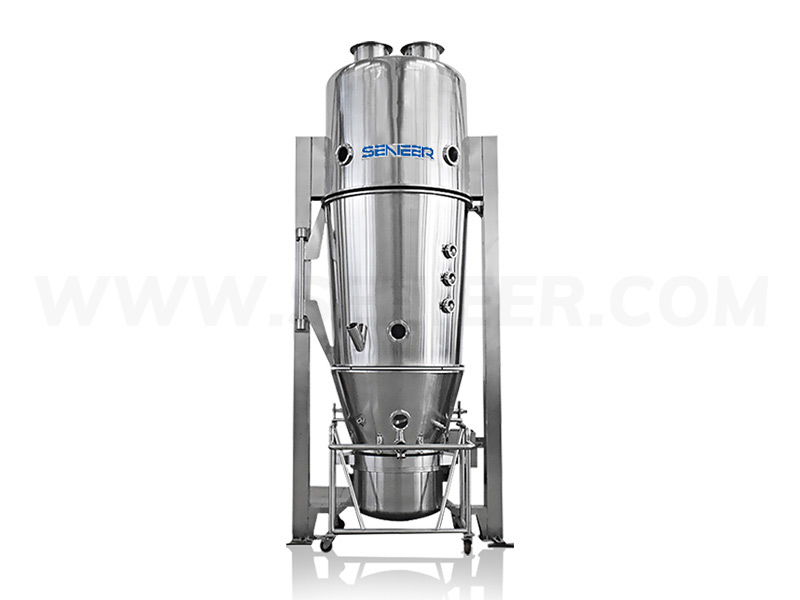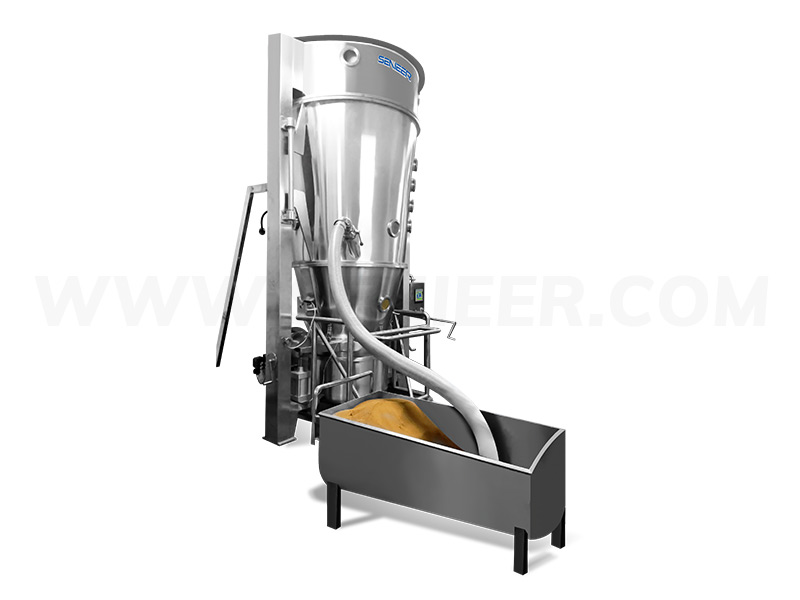There are currently three main types of fluid bed processes: top spray, bottom spray, and rotary tangential spray. Due to the different equipment construction, the material fluidization state is also different. Coating quality and formulation release characteristics may vary with different processes.

In principle, in order to make the coating film uniform and continuous, each process should minimize the travel of the coating droplets, that is, the distance of the droplets from the spray gun outlet to the surface of the substrate, so as to reduce the spray drying effect of the hot air on the droplets, so that the coating can be reduced. When the coating liquid reaches the surface of the substrate, it basically maintains its original characteristics, and the concentration and viscosity do not increase significantly, so as to ensure the ideal spreading and film-forming characteristics on the surface of the substrate, and form a uniform and continuous coating film.
1. Bottom Spraying Process
Also known as the Wurster system, it is the main application form of fluid bed coating, and has been widely used in the coating of pellets, granules, and even powders with a particle size of less than 50 μm.
There is a spacer in the center of the material tank of the bottom spray device, and an air distribution plate with many small circular holes at the bottom. Due to the different opening ratios of the chassis in the corresponding parts of the spacer, the inner/outer spacer is formed. Different air intake air intensities make the particles form a regular circular movement inside and outside the spacer. The spray gun is installed inside the spacer, and the spraying direction is the same as the moving direction of the material, so the inside of the spacer is the main coating area, and the outside of the spacer is the main drying area. The granules pass through the coating zone every few seconds, completing a coating-drying cycle. All particles have a similar chance of passing through the coating area, so the resulting coating is uniform and dense.
Experimental and pilot-scale equipment (air distribution pans up to 18 inches in diameter) use a spacer and spray gun to create a coating area. Large production facilities (air distribution chassis up to 46 inches in diameter) increase the number of spacers and guns, and expand the coating area to increase production efficiency.
Wurster HS is a new technology in the bottom spraying process. Some improvements have been made to the traditional Wurster spray gun system to make the particles avoid contacting the coating droplets that have not been fully atomized in the nozzle and the negative pressure area generated by the atomization pressure in the nozzle. Therefore, the probability of particle bonding is greatly reduced.

Compared To The Traditional Wurster System, In The Wurster HS System:
- The spray rate is increased by 3-4 times, and each spray gun can reach 500-600g/min, thus making full use of the drying efficiency of the fluid bed and shortening the production cycle;
- The spray gun can use higher atomization pressure to form very small atomized droplets to meet the coating requirements for particles smaller than 100μm;
- The granules avoid contact with the high-speed area ofcompressed air in the local area of the nozzle, which reduces the surface abrasion at the initial stage of coating and helps to maintain a constant specific surface area.
2. Tangent Spray Process
The material trough of the tangential spray device is cylindrical with a speed-adjustable turntable at the bottom. There is a gap between the turntable and the groove wall, which can pass the intake air flow. The size of the gap is adjusted by the height of the turntable to change the linear velocity of the incoming air flow. The particles are in a spiral centrifugal motion state due to the action of three forces: the centrifugal force generated by the rotation of the turntable, the driving force of the intake air flow, and the particle’s own gravity. The spray gun is installed on the side wall of the material tank, and the spray direction is along the tangential direction of the material movement.
Experimental equipment (turntable diameter up to 0.5 meters) generally uses a single spray gun, pilot-scale and large-scale production equipment (turntable diameter up to 2 meters) generally uses 2-6 spray guns.
Tangent Spray Technology Is Comparable To Bottom Spray Technology And Shares Three Physical Characteristics:
- Spray in the same direction, the spray gun is embedded in the material, and the stroke of the coating droplet is short;
- Equal chance of particles passing through the coating area;
- High particle density in the coating area and low spray loss.
Due to these characteristics, the quality of the coating film formed by tangential spraying is better, and the quality of the coating film formed by bottom spraying is comparable, and it can be suitable for aqueous or organic solvent coating process.

3. Top Spraying Process
The top spray process has been used for granulation for more than 50 years, and it has been widely used in coating in the past 30 years.
In the top spray device, the particles are pushed by the incoming air flow, and accelerate from the material tank through the coating area. The spraying direction of the spray gun is opposite to the moving direction of the particles. After passing through the coating area, the particles enter the expansion chamber, and the diameter of the expansion chamber is larger than that of the material tank, so the linear velocity of the airflow is weakened, and the particles fall back into the material tank under the action of gravity.
Compared To Bottom And Tangential Sprays, Top Sprays Are Relatively Less Effective For Coating Because:
- The fluid motion of particles is relatively irregular, so a small amount of particle sticking is often unavoidable, especially for small particles.
- In the reverse spray mode, the coating spray is in the opposite direction to the particle movement, so the distance from the spray gun outlet to the particle surface is relatively increased, and the incoming hot air volatilizes the droplet medium, which may affect the droplet viscosity and spreading. The film-forming properties and poor process control may even cause a large amount of spray drying of the coating solution. Therefore, the top spray process should not be used for organic solution coating as much as possible.
However, the top spray process is very suitable for hot melt coating. This process uses wax or ester materials to coat in a molten state without using solvents. It is characterized by a very short production cycle, which is very suitable for varieties with a relatively large coating amount and craft.
To form a high-quality film in hot melt coating, the temperature of the material must be kept close to the freezing point of the coating liquid during the coating process.
The coating liquid pipeline and atomizing compressed air must be heated and insulated to prevent the coating liquid from condensing in the presence of condensation. Some reports use Compritol 888 coating with a melting point of 69 to 74 °C to prepare theophylline pellets with controlled release for 8 hours, and there are reports to use white beeswax coating with a melting point of 61 to 65 °C to prepare potassium chloride slow-relea










